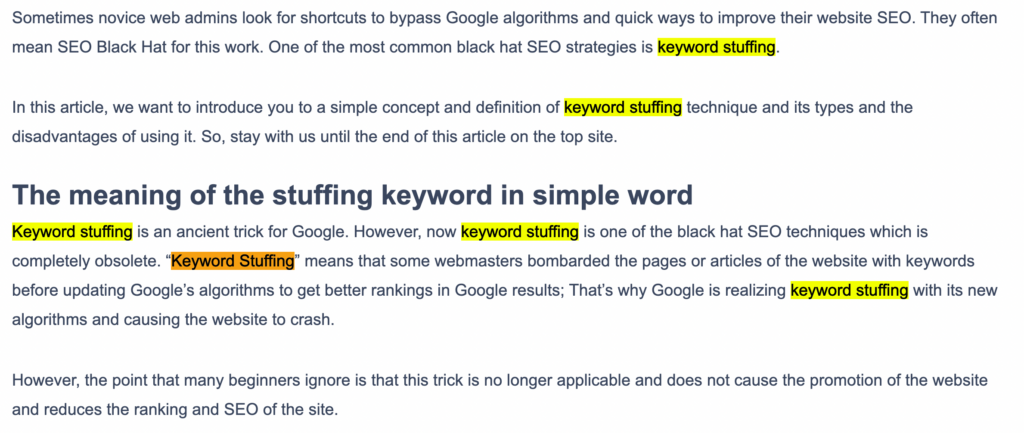How to Avoid Keyword Stuffing? What is Keyword Stuffing
- SEO Tutorials
- Updated on

Suppose you are familiar with the Internet business environment and website design. In that case, you must know that the most important and reputable way to promote a website in search engines, especially Google, is SEO. Like many years ago, Beginners today think that by repeating the main words and phrases of a page or article too much, they can increase their website traffic. However, you should know that keyword stuffing is an outdated technique and is completely wrong.
Sometimes novice web admins look for shortcuts to bypass Google algorithms and quick ways to improve their website SEO. They often mean SEO Black Hat for this work. One of the most common black hat SEO strategies is keyword stuffing.
In this article, we introduce you to a simple concept and definition of the keyword stuffing technique and its types, and the disadvantages of using it. So, stay with us until the end of this article on the top site.
The meaning of the stuffing keyword in simple word
Keyword stuffing is an old trick for Google. However, now it is one of the black hat SEO techniques which is completely obsolete. “Keyword Stuffing” means that some webmasters bombarded the pages or articles of the website with keywords before updating Google’s algorithms to get better rankings in Google results; That’s why Google is realizing this with its new algorithms and causing the website to crash.

However, the point that many beginners ignore is that this trick is no longer applicable and does not cause the promotion of the website and reduces the ranking and SEO of the site.
Types of Keyword Stuffing
As you have probably noticed, there are different types of keyword stuffing that you should be familiar with to avoid using on your website. In the following, we want to introduce you to different types of crucial stuffing.
Excessive repetition of the original phrase
One of the most common types of keyword stuffing is the excessive repetition of keyword phrases in posts and web pages. Suppose you want to write an article about website design with WordPress and publish it on your website, and the keyword of that article is “site design.”
If you use your keyword too much in an article or website post so that the eyes of users or readers of that article are annoyed to see the keyword, you have used keyword stuffing.
Use irrelevant keywords
You certainly have seen some pages on which the writer has used irrelevant words and phrases, which will help you and prevent you from finding what you were looking for and will make you leave the page. This is one of the crucial factors in lowering the website’s ranking.
Use of keywords outside the page subject
Another problem with most websites is the use of unnecessary and off-topic keywords. This means that the subject of the article does not match the keywords. This indicates that the webmaster or content creator of the site wants the keywords to rank in the search engines and still be used, even if they are irrelevant to the page’s main topic.
Destroy Keyword Stuffing of articles step by step
Before introducing a few ways to prevent Keyword Stuffing in articles and pages of a website, you can minimize the excessive use of keywords by using a comprehensive program for keyword density. At Mihan WordPress, we want to introduce you to a strategic plan for this task, which includes four essential steps:
1. Assign a keyword for each page or article, and know what word and how many times you want to use it in each paragraph.
2- Use images for the contents of more than 300 words and try to use the keywords of that page in the text instead of that image.
3- In this step, you should use words and phrases similar to the keywords of that article. You can also add synonyms or families of page keywords to the article.
4. Finally, if you use the WordPress content management system on your website, it is recommended that you check the density of your keywords using the plugins of Yoast, Rank Math, etc…
A few simple techniques to prevent keyword stuffing
What is the best way to avoid keyword stuffing on your website and article? What should we do to use too many words on a website? What is the correct and professional way to use keywords in the text?
In this section, we want to introduce you to 3 unique techniques for using keywords correctly in the article, So I suggest you read the rest of this article carefully.
Put yourself in the audience’s shoes.
The first way that most foreign SEO experts suggest to prevent the wrong keyword stuffing technique is to put yourself in the website user’s shoes. As everyone involved in internet business, web designers, SEO experts, and others know, producing content and publishing it on the website is to solve one or more different problems of the website users.
So, the best way not to use keyword stuffing and the most appropriate way to know if you have used this wrong trick in website articles or not is to put yourself in the users’ shoes and read the article from their point of view. In the meantime, you will notice the use or non-use of keywords and phrases.
Select the main phrase
The question that may arise for you is is there another solution? The answer should be “Yes.” To increase the chances of getting better rankings in search results, we need to choose a popular keyword. It is important to note that the keyword should not have much competition.
Of course, accessible and practical tools will show both the popularity of a word and the level of competition over that word. So, before creating a page or writing a website article, you should first choose a keyword related to it and know under what title you want that page to rank in Google results, and users will enter your website after searching for that keyword.
Use keywords with the proper density.
Another critical point that can help you in the repetition rate of the keywords is maintaining the proper density for the target keyword. It would help if you used the target keyword naturally and logically coordinated intervals throughout the article.
In short, we should not overuse a keyword and only use it where we feel it’s appropriate. Limit keyword density to less than 2% to comply with SEO standards and prevent keyword stuffing.
Conclusion
We hope you enjoy this article. This article has tried to define stuffing keywords and tell you about its disadvantages. We have also introduced you to techniques that you can use to survive Keyword Stuffing on your website.


To post a comment, please register or log in first.